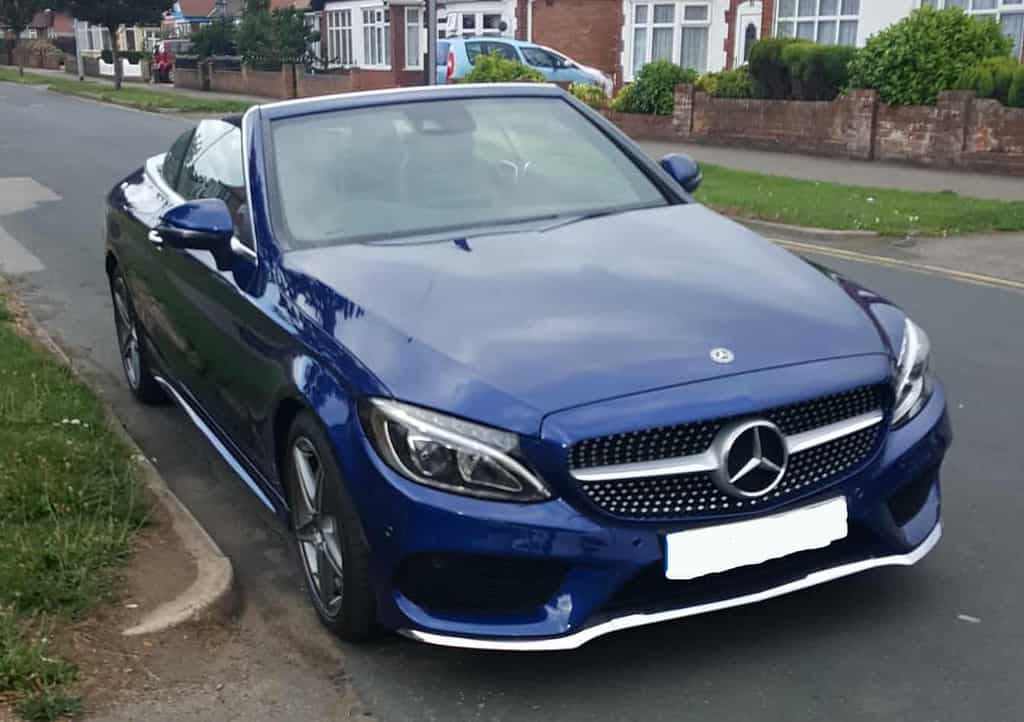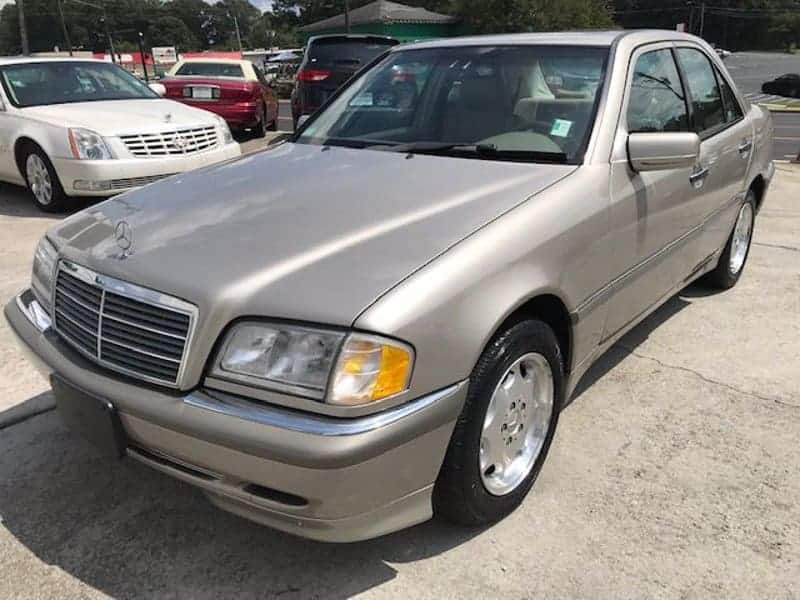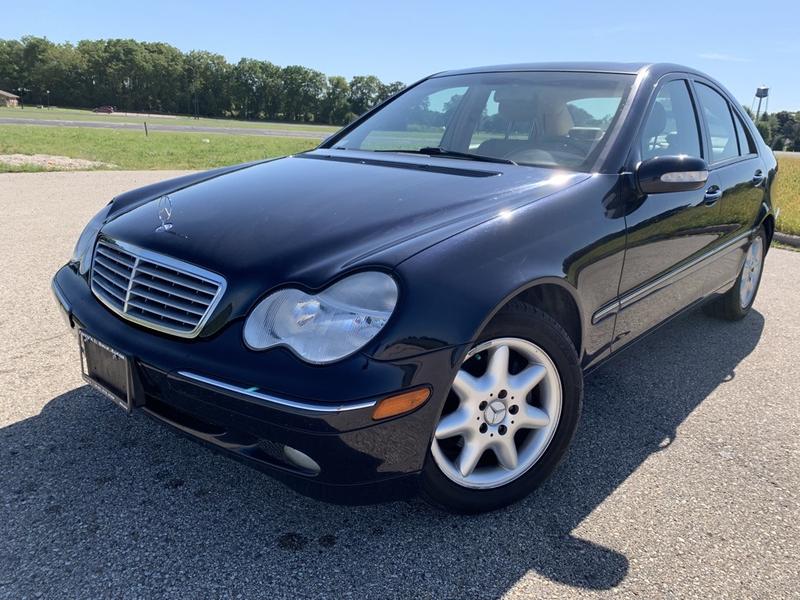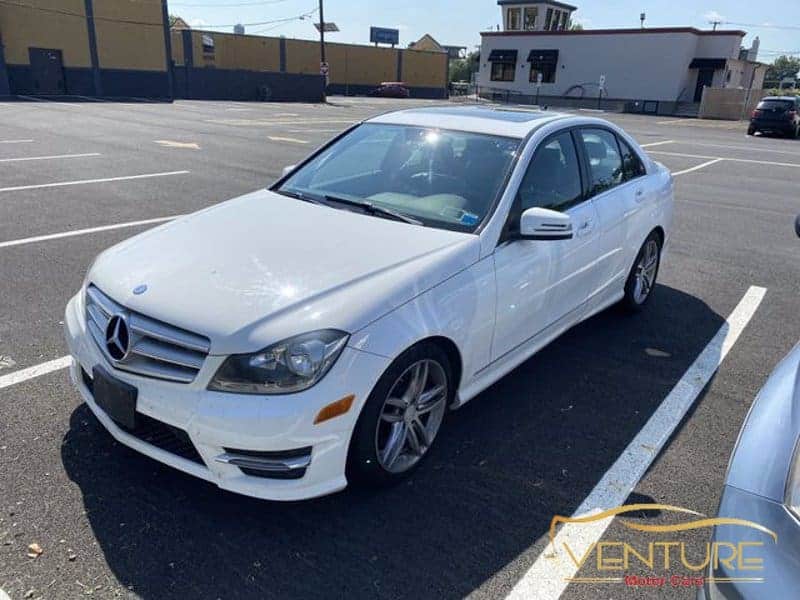What to Look for When Buying a Used Mercedes-Benz C Class

If you’re thinking of buying a compact executive car, the chances are the Mercedes-Benz C-Class will figure pretty high on your list of ones to consider. The C-Class has been in production since 1994 through four generations that Mercedes refers to as the W202, W203, W204, and W205. In this article, we’re going to look at what you need to look for when buying a used Mercedes-Benz C-Class.
- C-Class history
- First-generation (W202) Mercedes-Benz C-Class
- Second-generation (W203) Mercedes-Benz C-Class
- Third-generation (W204) Mercedes-Benz C-Class
- Fourth-generation (W205) Mercedes-Benz C-Class
- Fifth-generation (W206) Mercedes-Benz C-Class
- How much should you pay for a used C-Class?
- C-Class AMG models
- What’s special about the C-Class?
- Known C-Class problems
- The competition
- Should you buy a used Mercedes-Benz C-Class?
Mercedes-Benz C-Class history
In 1993 Mercedes-Benz had the not unsubstantial task of replacing the 190 series/W201, which was the relatively affordable gateway model that got people into the brand that were probably aspirational, but not necessarily awash with cash like many of those who bought the more expensive models the brand was renowned for. The old 190 models are still very well thought of and good examples are highly sought-after and can fetch good money, especially the AMG variants.
There have been a lot of different body styles in the C-Class family since 1993, but some are not as desirable as others. Sedans and wagons have been the mainstays of the family over the years and there have been some very nice coupes and convertibles too.
I have to say though; I never was and never will be a fan of the 2001-2005 coupes with those stubby rear-ends that made them among the most uninspiring coupe designs of all time.
The C-Class is probably something of an over-achiever for Mercedes in today’s market where sedan sales are pretty much dying in the face of the public’s obsession with all things SUV. The C-Class remains a popular car for those who want quality, luxury, and a prestigious badge without having to break the bank to pay for it.
Used models are perhaps even more popular because they don’t tend to age too badly, and they allow even more budget-conscious consumers to get themselves behind the wheel of their very own Mercedes-Benz for the first time.
If you want to get a used C-Class or other used vehicles for the lowest possible price, government and police auctions are the way to go. You need to know what you’re looking for to buy at auction, but this guide is a great place to find used vehicles at incredible prices.
First-generation (W202) Mercedes-Benz C-Class (1993-2000)

In 1993 Mercedes launched the first-generation of its new C-Class compact executive car after a design process that got underway in 1987. If you’re familiar with the 190 series/W201the C-Class was brought in to replace, you’ll probably notice that the C-Class wasn’t exactly a drastic departure from the 190 in terms of the way it looked. The W202 C-Class was still a notably fresher and more modern design, and it’s still a car that doesn’t look like a 30-year-old design even today.
With a couple of extra inches of length over the 190 and more luxurious interior, the first-generation C-Class was still powered by inline-four engines that were the hallmark of its predecessor. The W202 got its global debut in 1993 with a 120 horsepower 1.8-liter inline-four as its base engine, and these models were badged as the C180.
Also popular were the 2.0-liter C200 and 2.2-liter C220, and there were also more powerful 2.3-liter and 2.6-liter V-6 variants. Some C230 models also benefitted from a supercharger, which you can easily identify as they were badged as the C230 Kompressor.
A station wagon version of the C-Class was also available, but for some reason, it wasn’t offered for sale in North America at the time. In fact, the C-Class was only ever offered for sale in North America in wagon form for a very brief period. The new C-class quickly gained an enviable reputation for its quality and reliability, and it really did give its arch-rival, the BMW 3 Series, a run for its money from day one.
Second-generation (W203) Mercedes-Benz C-Class (2000-2007)

In 2003 we got the second-generation W203 version of the C-Class, but these redesigned models largely stuck with the same engines used by the previous generation. Unfortunately, this is where identifying what’s under the hood of a C-Class got a little more difficult because Mercedes decided that the number designations would no longer reflect the displacement of the engine.
If you’re looking to buy a W203 C200 you’d be wrong to expect a 2.0-liter engine under the hood as it will actually be a 1.8. Likewise, a C240 is powered by a 2.6-liter engine and not a 2.4-liter unit as you may expect from the badge.
For me, the styling of the W203 isn’t as timeless as the W202 and if were shopping for a classic C-Class I’d be searching for a W202 in good condition. There are three body styles to be found in the W203 family, which are the sedan, a station wagon and that liftback/coupe thing I’ve already expressed my lack of admiration for.
Unless you are especially enamored with this particular C-Class design, I’d skip it and find a little extra cash to buy a third-generation model if you can find a decent one within your budget.
Third-generation (W204) Mercedes-Benz C-Class (2007-2015)

If the W203 was a design that history might not look back on with particular fondness, the third-generation W204 was a return to form for the C-Class and even early examples still look the part today. You might notice quite a difference with models from the 2012 model year as the W204 got a facelift then. The 2012 models onwards got new LED taillights, a revised dashboard and instrument cluster layout, but it’s the revised front fascia and headlights that make facelifted models stand out.
Although the W204 was replaced by the new W205 in 2014, the W204 continued in production into the 2015 model year in C-Class Coupe form only.
Fourth-generation (W205) Mercedes-Benz C-Class (2014-today)

The fourth-generation C-Class that’s still current is another model where it’s something of a game of two halves. The W205 fourth-gen model went on sale as a 2015 model in America and it was the first car to use the all-new Modular Rear Architecture (MRA) platform that’s now shared with the bigger and more expensive E-Class and S-Class models. As well as a new, more contemporary design, the W205 is also significantly lighter thanks to its extensive use of aluminum and high-strength steel.
Mercedes has certainly been making the most of this latest version of the C-Class as you’ll find it in sedan, wagon, coupe, and convertible body styles and with a wide range of different engines in markets across the globe.
In 2018 the W205 got a noticeable facelift and the newer models are pretty easy to distinguish from the earlier versions of the fourth-generation C-Class, and there were also new engines to go with the new look.
Fifth-generation (W206) Mercedes-Benz C-Class (2022?)
An all-new, fifth-generation W206 C-Class is on the near horizon, and current opinion suggests it will arrive in mid-2021 as a 2022 model year. There are plenty of photographs of modestly-disguised test mules all over the internet, and it looks as though the next C-Class will look even more like a shrunken version of the latest S-Class.
In the wake of Covid-19 delays that are affecting production all over the globe, it’s impossible to say exactly when this important new model for Mercedes-Benz will finally arrive.
How much should you pay for a used Mercedes-Benz C-Class?
Unless you go for a complete junker, the least you can expect to pay for a Mercedes-Benz C-Class in America is probably around $2,300 for something like a 1997 C 280 sedan with a couple of hundred thousand miles or more on the odometer. You could possibly pay a little less for something newer, but that would be for one of those early coupe models such as around $2,000 for a 2003 C 230 Coupe.
Below is a table that gives you a rough guide of what you could expect to pay for a used C-Class.
| Generation / Model Years | Price Range | Average Price |
|---|---|---|
| 1st Generation 1993-2000 | $2,000 – $5,500 | $4,257* |
| 2nd Generation 2000-2007 | $2,300 – $13,000 | $5,186* |
| 3rd Generation 2007-2015 | $4,300 – $34,000 | $12,429* |
| 4th Generation 2015-2020 | $13,400 – $54,400 | $33,325* |
* I need to point out that in collating these figures I’ve avoided including AMG models, which are considerably more expensive than the majority of C-Class models and deserve to be considered almost as a separate model in their own right.
C-Class AMG models

If you want to know what car it was that inspired Cadillac to come up with the fabulously unnecessary CTS-V a few years ago you don’t need to look any further than the Mercedes-Benz C-Class AMG models. Over the years there have been C 32, C 36, C 43, C 55, and C 63 AMG versions of the C-Class, and these really are very special cars indeed.
You can pay as little as $10,000 for something like a 2002 C 32 AMG with just over a hundred thousand miles on the clock, but you could pay even more for a W202 in good condition. Without going over the top on price too much, I’d say a good buy would be something like a 2009 C 63 AMG sedan that you can probably pick up for around $21,500 with below-average miles.
What’s special about the C-Class?
The Mercedes-Benz C-Class is probably in a class where it only has one rival of similar stature, and that rival is the BMW 3 Series. Yes, there are lots of other compact luxury sedans you can buy from the likes of Audi, Lexus, Cadillac, and others, but none of them quite have the cache and allure of the Mercedes or BMW badges.
You can, of course, pay an awful lot of money for a used C-Class, but those are not the models most people think of when it comes to these excellent compact luxury cars. For an awful lot of car buyers all around the world, a used C-Class represents a way of getting a luxury car with an even more prestigious badge on the hood that will serve them well for years to come, but at a very attractive price.
You can get your hands on a used 2009 Mercedes-Benz C 300 4MATIC Sedan with 42,000 miles on the odometer for less than $10,000, which is the same as you’d pay for a 2012 Chevrolet Malibu LT with the same miles. Which would you rather have, and which one will still be going strong in another 10 years?
Known C-Class problems to watch out for
Rust – Although it’s not a problem with later models, early examples do suffer from rust in several common places. Behind the license plate is one area where rust likes to gain a foothold, but you also need to look under the wheel wells, near the bumpers, the front fenders, and on the rear quarter panels. At the bottom of the doors is another area where rust can occur, but it’s rarely a cheap fix with a Mercedes wherever you find it.
Engine Mounts – To reduce the chances of engine vibrations being transmitted to the car’s cabin, Mercedes fills its engine mounts with oil. At around 100,000 miles these oil-filled engine mounts often start to fail and lose oil. When this is happening you’ll start to notice excessive vibration through the seat and steering wheel and the solution is to get the engine mounts replaced.
The good news is replacement mounts can be relatively inexpensive to buy online, but the bad news it will take between four and six man-hours for the garage to remove the old ones and fit the new ones.
Suspension & Steering Components – Despite the C-Class being a prestige car, components such as ball joints, sway bar links, and control arm bushings have an unwanted tendency to wear out a lot quicker than you’d probably expect. Mercedes-Benz specialists have told me that if you take a Mercedes-Benz like a C-Class in for a state inspection if it’s done 100,000 miles or more there’s every chance it will fail due to suspension issues.
Window Regulators – Electric windows are something we take for granted these days, but if you take a moment to think about them it’s hardly surprising they’re prone to fail as the years going up and down go past. This isn’t a fault that’s peculiar to the C-Class or even Mercedes-Benz as a whole, but the C-Class is quite prone to faulty window regulators and it’s something you need to consider before buying a used C-Class.
Replacing a window regulator could be a DIY job if you have the patience, but an independent specialist will charge between $350 and $500 to do the work and a Mercedes dealer will charge you even more than that.
Active Driving Sensors – This is one of those innovative Mercedes features that help set the C-Class apart from its rivals and allows you to get the absolute most out of every single mile you drive. However, these active driving sensors have been known to fail on the C-Class sometimes and strong vibrations that can make your vehicle feel unstable when driving are the main symptom to look out for.
If you feel that kind of vibration on a test drive and it does turn out to be the active driving sensors, they will need replacing to fix the problem.
Engine failure – While for the most part, the majority of engines used in the C- Class have proved to be extremely durable and reliable, if you’re looking at a C-Class manufactured between 2000 and 2009 you’ll need to pay extra attention to the engine. Engine failure in these models typically occurs as a result of failing electrical connections within the engine system.
These failed connections can lead to the crankshaft sensors malfunctioning, which then leads to the engine failing and then you’ll be going nowhere fast. As you might expect, with a C-Class this can be quite an expensive repair as the engine will have to be completely reset and the electronics repaired.
Brakes (2010) – There isn’t a continuing theme of brake failure with the C-Class by any means, but there was a particular problem with the 2010 model year. The problem arose as a consequence of a manufacturing error that saw incorrect discs installed on a large proportion of C-Class models build in 2010.
Therefore, if you’re interested in a 2010 used Mercedes C-Class it’s a good idea to make sure there’s some record in the service history of new discs being fitted at some point. Otherwise, you’ll have to factor the cost of replacing them into your budget.
C-Class rivals
I’m tempted to say there isn’t any serious rival to the C-Class apart from the BMW 3 Series, but that’s not strictly true, of course. While the 3 Series is undeniably the main fiercest rival of the Mercedes, there are other models you might want to consider that fall into the same class of compact luxury cars.
The obvious other German rivals are the Audi A4 and the Audi A5, but you may also want to consider the Jaguar XE, Cadillac ATS, Infiniti Q50, and the Lexus IS.
Should you buy a used Mercedes-Benz C-Class?

I would stick my neck out far enough to say that if you’re in the market for a high-quality, luxurious and prestigious four-door sedan for a very reasonable amount of money, there really isn’t another car to consider. The C-Class just has something about it that even the BMW 3 Series can’t quite match.
First-generation C-Class models in good condition are not just a good car for their age, and for how little you can pick one up for, they’re probably going to appreciate in value as time goes by as long as you look after them. There’s something about that three-pointed star on the hood that you just don’t get with other brands – not even BMW.
Like any car that’s been around for such a long time, there are good ones and there are bad ones. The trick is doing your homework by reading articles like this to try and identify an example that suits you and your budget.
Fourth-generation models probably appeal to a different audience than second and third-generation examples. If you’ve always dreamed of owning and driving a Mercedes but there’s no way you can afford a new one or even a late-model used C-Class, a first, second, or third-gen C-Class is the way to go. If you’ve got between $10,000 and $15,000 to spend on a quality used sedan you’ll have to go a long way to find a better car to spend your money on than a Mercedes-Benz C-Class.
